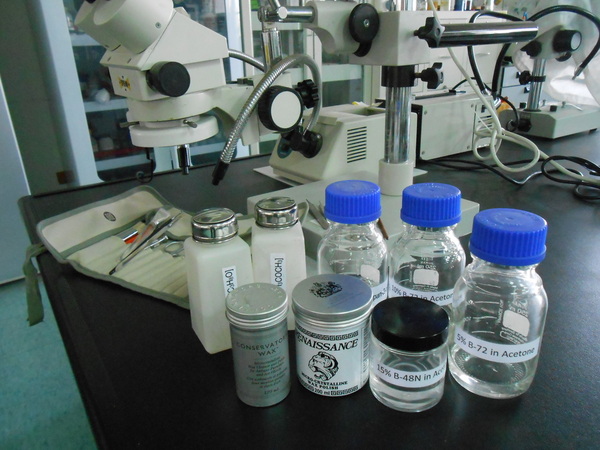Conservation Materials
Conservators use specialist materials when cleaning, treating, stabilizing and restoring cultural objects. Sometimes these are developed especially for the conservation profession but more usually they are developed for use in other industries and have been adapted for use in conservation.
Always, however, the materials have been thoroughly tested for suitability. To qualify as good conservation materials they must pass a number of tests. They should be:
Reversible - any adhesives or lacquers should not be permanent. They should redissolve in a suitable solvent if for any reason the object needs to be re-conserved in the future. Epoxy (two-part) adhesives and "instant" cyanoacrylate "superglues" are not suitable for cultural heritage objects.
Non-yellowing - coatings and lacquers should not deteriorate and turn yellow or brown in the future.
Non-harmful - any chemical or other treatment should not cause future deterioration of the object. Some commercial adhesives contain ammonia, acetic acid or will deteriorate to release other acids. Few commercial adhesives and coatings are designed to last for several decades - a pre-requisite for conservation materials. Commercial products are expected to sit in a shop for months or years before being used. They therefore contain stabilisers and other additives that may damage objects.
Click on the link to see what can happen when the wrong kinds of materials are used:
http://www.hairpinmuseum.org/wrong-kind-of-glue.html
http://www.hairpinmuseum.org/cleaning.html
Of course professional conservators are trained in the safe handling of solvents and other potentially dangerous chemicals without the risk of damaging their own health or the environment.
Always, however, the materials have been thoroughly tested for suitability. To qualify as good conservation materials they must pass a number of tests. They should be:
Reversible - any adhesives or lacquers should not be permanent. They should redissolve in a suitable solvent if for any reason the object needs to be re-conserved in the future. Epoxy (two-part) adhesives and "instant" cyanoacrylate "superglues" are not suitable for cultural heritage objects.
Non-yellowing - coatings and lacquers should not deteriorate and turn yellow or brown in the future.
Non-harmful - any chemical or other treatment should not cause future deterioration of the object. Some commercial adhesives contain ammonia, acetic acid or will deteriorate to release other acids. Few commercial adhesives and coatings are designed to last for several decades - a pre-requisite for conservation materials. Commercial products are expected to sit in a shop for months or years before being used. They therefore contain stabilisers and other additives that may damage objects.
Click on the link to see what can happen when the wrong kinds of materials are used:
http://www.hairpinmuseum.org/wrong-kind-of-glue.html
http://www.hairpinmuseum.org/cleaning.html
Of course professional conservators are trained in the safe handling of solvents and other potentially dangerous chemicals without the risk of damaging their own health or the environment.

